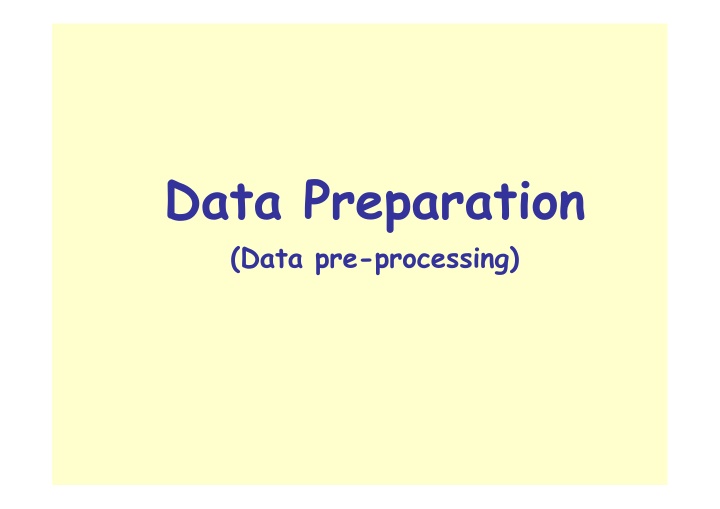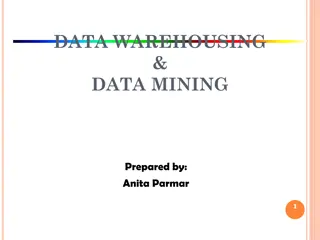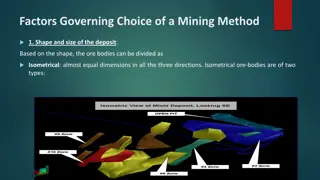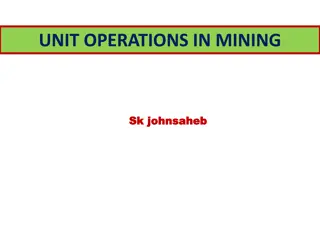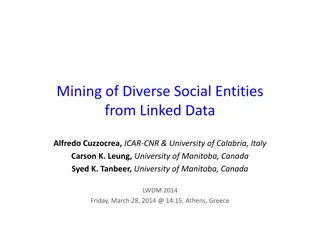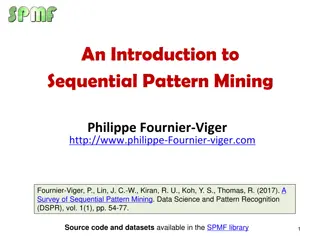Importance of Data Preparation in Data Mining
Data preparation, also known as data pre-processing, is a crucial step in the data mining process. It involves transforming raw data into a clean, structured format that is optimal for analysis. Proper data preparation ensures that the data is accurate, complete, and free of errors, allowing mining tools to generate more accurate and reliable results. By addressing issues such as outliers, missing values, and data transformation, data preparation sets the foundation for successful data mining projects.
Download Presentation

Please find below an Image/Link to download the presentation.
The content on the website is provided AS IS for your information and personal use only. It may not be sold, licensed, or shared on other websites without obtaining consent from the author.If you encounter any issues during the download, it is possible that the publisher has removed the file from their server.
You are allowed to download the files provided on this website for personal or commercial use, subject to the condition that they are used lawfully. All files are the property of their respective owners.
The content on the website is provided AS IS for your information and personal use only. It may not be sold, licensed, or shared on other websites without obtaining consent from the author.
E N D
Presentation Transcript
Data Preparation (Data pre-processing)
Data Preparation Introduction to Data Preparation Types of Data Outliers Data Transformation Missing Data 2
INTRODUCTION TO DATA PREPARATION 3
Why Prepare Data? Some data preparation is needed for all mining tools The purpose of preparation is to transform data sets so that their information content is best exposed to the mining tool Error prediction rate should be lower (or the same) after the preparation as before it 4
Why Prepare Data? Preparing data also prepares the miner so that when using prepared data the miner produces better models, faster GIGO - good data is a prerequisite for producing effective models of any type 5
Why Prepare Data? Data need to be formatted for a given software tool Data need to be made adequate for a given method Data in the real world is dirty incomplete: lacking attribute values, lacking certain attributes of interest, or containing only aggregate data e.g., occupation= noisy: containing errors or outliers e.g., Salary= -10 , Age= 222 inconsistent: containing discrepancies in codes or names e.g., Age= 42 Birthday= 03/07/1997 e.g., Was rating 1,2,3 , now rating A, B, C e.g., discrepancy between duplicate records e.g., Endere o: travessa da Igreja de Nevogilde Freguesia:Paranhos 6
Major Tasks in Data Preparation Data discretization Part of data reduction but with particular importance, especially for numerical data Data cleaning Fill in missing values, smooth noisy data, identify or remove outliers, and resolve inconsistencies Data integration Integration of multiple databases, data cubes, or files Data transformation Normalization and aggregation Data reduction Obtains reduced representation in volume but produces the same or similar analytical results 7
Data Preparation as a step in the Knowledge Discovery Process Knowledge Evaluation and Presentation Data Mining Selection and Transformation DW Cleaning and Integration DB 8
Types of Measurements Nominal scale content More information Categorical scale Qualitative Ordinal scale Interval scale Quantitative Ratio scale Discrete or Continuous 10
Types of Measurements: Examples Nominal: ID numbers, Names of people Categorical: eye color, zip codes Ordinal: rankings (e.g., taste of potato chips on a scale from 1-10), grades, height in {tall, medium, short} Interval: calendar dates, temperatures in Celsius or Fahrenheit, GRE (Graduate Record Examination) and IQ scores Ratio: temperature in Kelvin, length, time, counts 11
Data Conversion Some tools can deal with nominal values but other need fields to be numeric Convert ordinal fields to numeric to be able to use > and < comparisons on such fields. A A- 3.7 B+ 3.3 B 3.0 4.0 Multi-valued, unordered attributes with small no. of values e.g. Color=Red, Orange, Yellow, , Violet for each value v create a binary flag variable C_v , which is 1 if Color=v, 0 otherwise 20
Conversion: Nominal, Many Values Examples: US State Code (50 values) Profession Code (7,000 values, but only few frequent) Ignore ID-like fields whose values are unique for each record For other fields, group values naturally : e.g. 50 US States 3 or 5 regions Profession select most frequent ones, group the rest Create binary flag-fields for selected values 13
OUTLIERS 14
Outliers Outliers are values thought to be out of range. An outlier is an observation that deviates so much from other observations as to arouse suspicion that it was generated by a different mechanism Can be detected by standardizing observations and label the standardized values outside a predetermined bound as outliers Outlier detection can be used for fraud detection or data cleaning Approaches: do nothing enforce upper and lower bounds let binning handle the problem 15
Outlier detection Univariate Compute mean and std. deviation. For k=2 or 3, x is an outlier if outside limits (normal distribution assumed) (x ks,x + ks) 16
Outlier detection Univariate Boxplot: An observation is an extreme outlier if (Q1-3 IQR, Q3+3 IQR), where IQR=Q3-Q1 (IQR = Inter Quartile Range) and declared a mild outlier if it lies outside of the interval (Q1-1.5 IQR, Q3+1.5 IQR). http://www.physics.csbsju.edu/stats/box2.html 44
> 3 L > 1.5 L L 19
Outlier detection Multivariate Clustering Very small clusters are outliers http://www.ibm.com/developerworks/data/li brary/techarticle/dm-0811wurst/ 20
Outlier detection Multivariate Distance based An instance with very few neighbors within D is regarded as an outlier Knn algorithm 21
A bi-dimensional outlier that is not an outlier in either of its projections. 22
Recommended reading Only with hard work and a favorable context you will have the chance to become an outlier!!! 23
Normalization For distance-based methods, normalization helps to prevent that attributes with large ranges out-weight attributes with small ranges min-max normalization z-score normalization normalization by decimal scaling 25
Normalization min-max normalization v minv maxv minv v'= (new_max v new_min ) v +new_minv z-score normalization v ' =v v does not eliminate outliers v normalization by decimal scaling Where j is the smallest integer such that Max(| v'|)<1 v v'= 10 j range: -986 to 917 => j=3 -986 -> -0.986 917 -> 0.917 26
Age 44 35 34 34 39 41 42 31 28 30 38 36 42 35 33 45 34 65 66 38 min max (0 1) z score dec.scaling 0.421 0.450 0.184 0.450 0.158 0.550 0.158 0.550 0.289 0.050 0.342 0.150 0.368 0.250 0.079 0.849 0.000 1.149 0.053 0.949 0.263 0.150 0.211 0.350 0.368 0.250 0.184 0.450 0.132 0.649 0.447 0.550 0.158 0.550 0.974 2.548 1.000 2.648 0.263 0.150 0.44 0.35 0.34 0.34 0.39 0.41 0.42 0.31 0.28 0.3 0.38 0.36 0.42 0.35 0.33 0.45 0.34 0.65 0.66 0.38 28 66 minimun maximum 39.50 avgerage 10.01 standard deviation 5 3
MISSING DATA 28
Missing Data Data is not always available E.g., many tuples have no recorded value for several attributes, such as customer income in sales data Missing data may be due to equipment malfunction inconsistent with other recorded data and thus deleted data not entered due to misunderstanding certain data may not be considered important at the time of entry not register history or changes of the data Missing data may need to be inferred. Missing values may carry some information content: e.g. a credit application may carry information by noting which field the applicant did not complete 29
Missing Values There are always MVs in a real dataset MVs may have an impact on modelling, in fact, they can destroy it! Some tools ignore missing values, others use some metric to fill in replacements The modeller should avoid default automated replacement techniques Difficult to know limitations, problems and introduced bias Replacing missing values without elsewhere capturing that information removes information from the dataset 30
How to Handle Missing Data? Ignore records (use only cases with all values) Usually done when class label is missing as most prediction methods do not handle missing data well Not effective when the percentage of missing values per attribute varies considerably as it can lead to insufficient and/or biased sample sizes Ignore attributes with missing values Use only features (attributes) with all values (may leave out important features) Fill in the missing value manually tedious + infeasible? 31
How to Handle Missing Data? Use a global constant to fill in the missing value e.g., unknown . (May create a new class!) Use the attribute mean to fill in the missing value It will do the least harm to the mean of existing data If the mean is to be unbiased What if the standard deviation is to be unbiased? Use the attribute mean for all samples belonging to the same class to fill in the missing value 32
How to Handle Missing Data? Use the most probable value to fill in the missing value Inference-based such as Bayesian formula or decision tree Identify relationships among variables Linear regression, Multiple linear regression, Nonlinear regression Nearest-Neighbour estimator Finding the k neighbours nearest to the point and fill in the most frequent value or the average value Finding neighbours in a large dataset may be slow 33
How to Handle Missing Data? Note that, it is as important to avoid adding bias and distortion to the data as it is to make the information available. bias is added when a wrong value is filled-in No matter what techniques you use to conquer the problem, it comes at a price. The more guessing you have to do, the further away from the real data the database becomes. Thus, in turn, it can affect the accuracy and validation of the mining results. 35
Summary Every real world data set needs some kind of data pre-processing Deal with missing values Correct erroneous values Select relevant attributes Adapt data set format to the software tool to be used In general, data pre-processing consumes more than 60% of a data mining project effort 36
References Data preparation for data mining , Dorian Pyle, 1999 Data Mining: Concepts and Techniques , Jiawei Han and Micheline Kamber, 2000 Data Mining: Practical Machine Learning Tools and Techniques with Java Implementations , Ian H. Witten and Eibe Frank, 1999 Data Mining: Practical Machine Learning Tools and Techniques second edition , Ian H. Witten and Eibe Frank, 2005 DM: Introduction: Machine Learning and Data Mining, Gregory Piatetsky-Shapiro and Gary Parker (http://www.kdnuggets.com/data_mining_course/dm1-introduction-ml-data-mining.ppt) ESMA 6835 Mineria de Datos (http://math.uprm.edu/~edgar/dm8.ppt) 37
